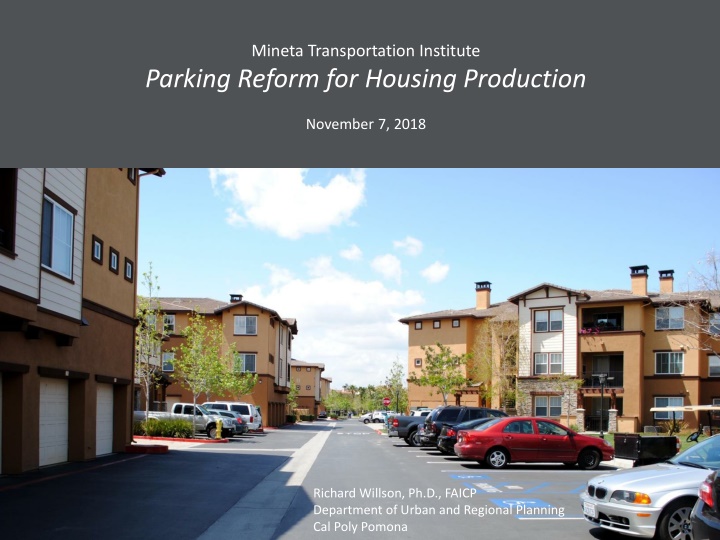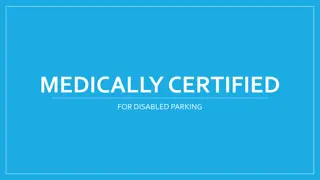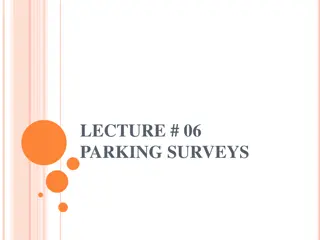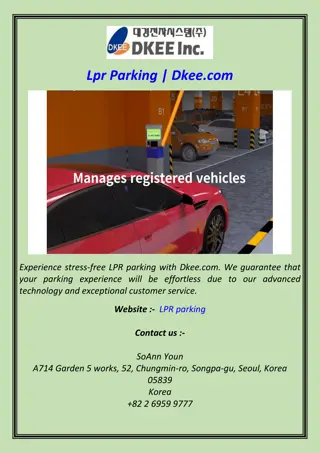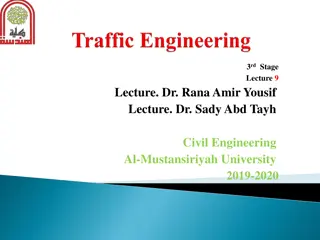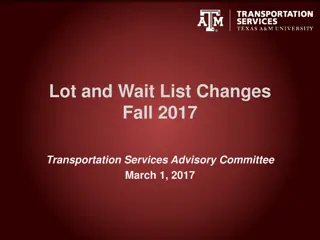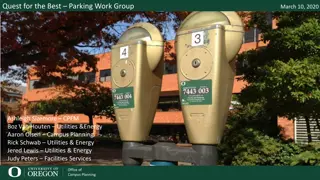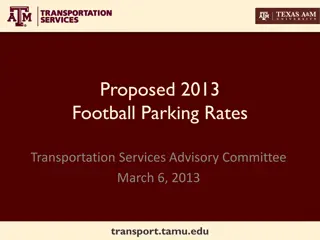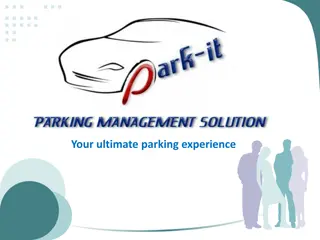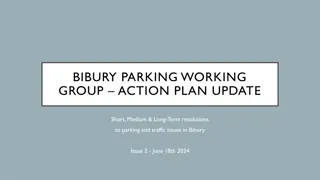Challenges and Solutions in Parking Reform for Housing Production
Richard Willson, Ph.D., discusses the issues surrounding parking in housing production, addressing challenges such as peak use parking, walkability, land use barriers, and parking anxiety due to high people density. The presentation highlights the need to reevaluate parking policies, consider stakeholder motivations, and leverage public benefits for affordable housing.
Download Presentation

Please find below an Image/Link to download the presentation.
The content on the website is provided AS IS for your information and personal use only. It may not be sold, licensed, or shared on other websites without obtaining consent from the author.If you encounter any issues during the download, it is possible that the publisher has removed the file from their server.
You are allowed to download the files provided on this website for personal or commercial use, subject to the condition that they are used lawfully. All files are the property of their respective owners.
The content on the website is provided AS IS for your information and personal use only. It may not be sold, licensed, or shared on other websites without obtaining consent from the author.
E N D
Presentation Transcript
Mineta Transportation Institute Parking Reform for Housing Production November 7, 2018 Richard Willson, Ph.D., FAICP Department of Urban and Regional Planning Cal Poly Pomona
Single site, peak use parking Walkability and land use challenges
Fine grained livability Roadblocks to revitalization
Built out, small parcels ..people density = parking anxiety
The circle of vice
Parking is policy
Putting parking requirements in their place
Habit, leverage, addiction, or what?
Stakeholder Reason for the Status Quo Maintain free parking Individuals who park Territoriality
Stakeholder Reason for the Status Quo Maintain free parking Individuals who park Territoriality Leverage public benefits, e.g., affordable housing. Local planners Nexus questions for other types of fees
Stakeholder Reason for the Status Quo Maintain free parking Individuals who park Territoriality Leverage public benefits, e.g., affordable housing. Local planners Nexus questions for other types of fees Public works/police Less on-street parking management and enforcement
Stakeholder Reason for the Status Quo Maintain free parking Individuals who park Territoriality Leverage public benefits, e.g., affordable housing. Local planners Nexus questions for other types of fees Public works/police Less on-street parking management and enforcement Reduce risk Development community Level playing field with competitors Other parking standards: tenants, lenders, appraisers, etc.
Stakeholder Reason for the Status Quo Maintain free parking Individuals who park Territoriality Leverage public benefits, e.g., affordable housing. Local planners Nexus questions for other types of fees Public works/police Less on-street parking management and enforcement Reduce risk Development community Level playing field with competitors Other parking standards: tenants, lenders, appraisers, etc. NIMBY groups Limit density, challenge projects
A twelve-step reform method
Step 1 Method Comments Measure local utilization using counts, air photo interpretation, census data (vehicle availability) for housing Existing rates may reflect past practice of free parking, separated land uses Existing utilization
Step 2 Method Comments Identify 20 year trends in demographics, economics, culture Future baseline Most trends suggest declining parking utilization rates Likely Effect Per Unit of Development - - - + - - - - ~ - - Factor Local and regional land use and transportation plans Demographic changes, aging population Dense, mixed-use development Changes in intensity of occupancy Transit development and non-motorized transportation Energy prices Congestion as a travel disincentive TNC s and autonomous vehicles lower fleet size Telecommunication substitution of travel Cultural preferences Parking management, shared parking, and pricing
https://www.economist.com/news/special-report/21737422-carmakers-tech-https://www.economist.com/news/special-report/21737422-carmakers-tech- companies-and-ride-hailing-firms-are-all-fighting-piece
Step 3 Method Comments Higher percentiles (e.g., 85th) are wasteful Basis for the rate Should requirements be based on average or percentile rates? Shared parking reduces risk of using average rate 33rd % 85th % Minimum Average Maximum Adjustment 0.3 .9 1.0 1.21 1.96 Rate 0.9 2.7 3.0 3.63 5.88
Step 4 Method Comments Adjust for special characteristics of the land use and the subarea May lead to differentiated rates in land use categories; affordable housing a prime example Project and context
Step 5 Method Comments Adjust for impact of pricing policies renting/buy parking separate from residential unit Pricing/un- bundling/ cashout Studies of price elasticity show that parking demand is responsive to price -0.3 +/-
Step 6 Method Comments Transit/ pedestrian/ bicycle Adjust for local and subregional plans for alternative access Affects travel mode choice for all land uses; affects household vehicle ownership for housing
Step 7 Method Comments Adjust for assigned versus pooled spaces, circulation factor Real-time parking information and guidance systems reduce need for circulation factor Space use efficiency
Step 8 Method Comments Districts may be oversupplied with parking. Overnight parking for residential uses could occupy empty spaces in office buildlings Reduce on-site requirement to account for portion of off-site parking Off-site parking
Step 9 Method Comments Land uses can be strategically selected to maximize shared parking potential. A challenge for residential uses, but growing in use in urban areas Internal shared parking For multi-use sites, reduce overall rate to account for different peak use periods Use Urban Land Institute Shared Parking or free models (MTC)
Step 10 Method Comments Consider transportation, urban form, housing affordability, economic development, sustainability, and regulatory practicality Evaluate and iterate Does the prospective rate support community goals? Administrative feasibility +
Step 11 Method Comments Average vehicle size is declining. If spaces are assigned, can allocate by vehicle size Decide on minimum size, compact spaces Space size
Step 12 Method Comments Potential varies by land use, district context, and market. Tenant prefer side-by-side, but large density gains possible, lowering housing cost Tandem, valet, mechanical Increase the yield of cars parked per square foot of land or building area
Requirement options and developer responses
Approach Requirement Developer response Minimum > utilization No maximum Traditional Rarely build more than requirement Moderate reform Minimum = utilization No maximum Assess market for project, may exceed minimum
Approach Requirement Developer response Minimum > utilization No maximum Traditional Rarely build more than requirement Moderate reform Minimum = utilization No maximum Assess market for project, may exceed minimum Big city approach Minimum = % of utilization Maximum = ratio or % of minimum Market decision whether to supply minimum or build to maximum
Approach Requirement Developer response Minimum > utilization No maximum Traditional Rarely build more than requirement Moderate reform Minimum = utilization No maximum Assess market for project, may exceed minimum Big city approach Minimum = % of utilization Maximum = ratio or % of minimum Market decision whether to supply minimum or build to maximum Partial deregulation No minimum Market decision whether to supply parking or build to maximum Maximum = ratio or % of minimum No minimum or maximum; Performance measures, e.g., traffic impacts Deregulation Market decision on whether/how much
Priorities Reform How to sell it Allow on-street parking to be counted for visitor parking On-street parking is traditionally devoted to short-term visitor uses 1 Eliminate visitor parking requirement 2 On-street parking pricing manages use
Priorities Reform How to sell it Allow on-street parking to be counted for visitor parking On-street parking is traditionally devoted to short-term visitor uses 1 Eliminate visitor parking requirement 2 On-street parking pricing manages use Unbundle parking cost from rent or purchase price Non-auto households deserve lower housing costs 3 Lower minimums to expected vehicle availability Lower housing costs, allow greater density 4
Priorities Reform How to sell it Allow on-street parking to be counted for visitor parking On-street parking is traditionally devoted to short-term visitor uses 1 Eliminate visitor parking requirement 2 On-street parking pricing manages use Unbundle parking cost from rent or purchase price Non-auto households deserve lower housing costs 3 Lower minimums to expected vehicle availability Lower housing costs, allow greater density 4 Lower minimums to below expected vehicle availability 5 Allow for market choice 6 No minimum requirement Market decision on whether/how much
Priorities Alternatives to parking How to sell it Free transit passes to residents for defined period 1 Lowers vehicle ownership rates Provide spaces for temporary car rental, shared mobility pickup 2 As above
Priorities Alternatives to parking How to sell it Free transit passes to residents for defined period 1 Lowers vehicle ownership rates Provide spaces for temporary car rental, shared mobility pickup 2 As above Accommodates a more efficient mode 3 Bicycle parking Agree to add mechanical parking if needed, based on monitoring Reduces risk perceived by city in lowering minimums 4
Priorities Alternatives to parking How to sell it Free transit passes to residents for defined period 1 Lowers vehicle ownership rates Provide spaces for temporary car rental, shared mobility pickup 2 As above Accommodates a more efficient mode 3 Bicycle parking Agree to add mechanical parking if needed, based on monitoring Reduces risk perceived by city in lowering minimums 4 Preference for rentals to those employed locally 5 Argues for lower vehicle ownership Pedestrian improvements, bike facilities Enhances alternative modes, for residents and neighborhoods 6
Bells and whistles
Taming Parking Driveway regulations Prohibit surface Ground floor retail Height restrictions % of block facades for garage doors Discretionary design review Shading Permeable pavement Solar Real-time information Guidance systems
Taming Parking Supply Regulations Eliminate minimums Maximums Discretionary determination Tandem Re-use projects Overlays zones On-street credit Performance- based In lieu/access fees Carsharing Off-site parking Pricing, unbundling, cash- out TDM Bike parking Electric vehicle parking Driveway regulations Prohibit surface Ground floor retail Height restrictions % of block facades for garage doors Discretionary design review Shading Permeable pavement Solar Real-time information Guidance systems
Parking management
Approach Strategy Time limits, space designations Pricing Dynamic pricing Parking benefit districts On-street parking in commercial districts Residential permits Priced residential permits Parking benefit districts On-street parking in residential neighborhoods
Approach Strategy Time limits, space designations Pricing Dynamic pricing Parking benefit districts On-street parking in commercial districts Residential permits Priced residential permits Parking benefit districts On-street parking in residential neighborhoods Access control Pricing Off-street parking, private Shared parking arrangements Time limits, space designations Cost recovery pricing Prioritize use through pricing Off-street parking, public
Politics and participation
